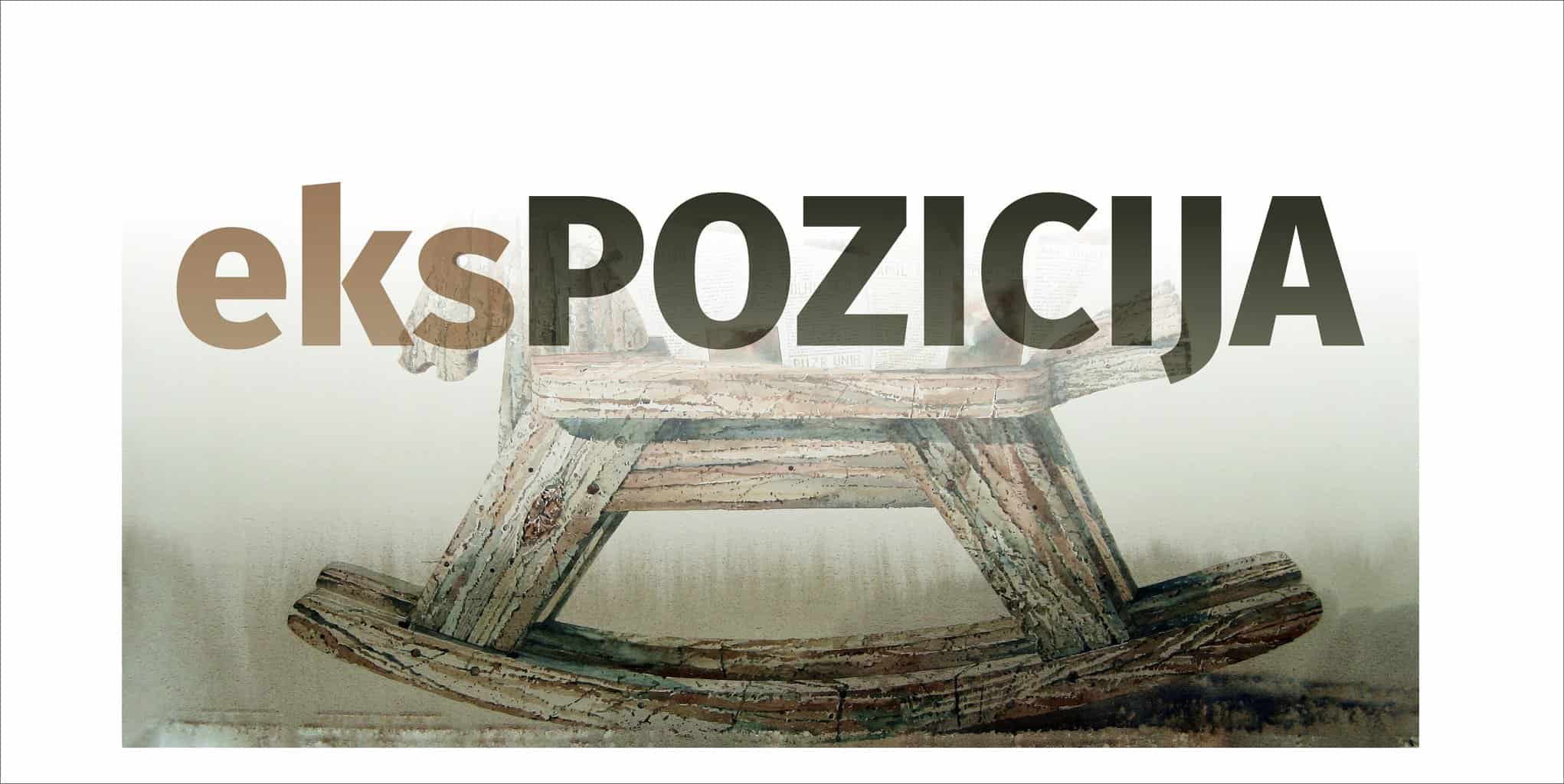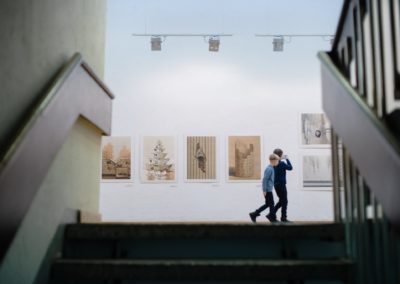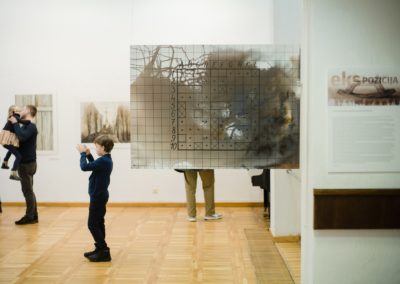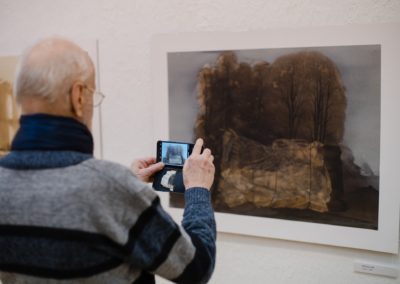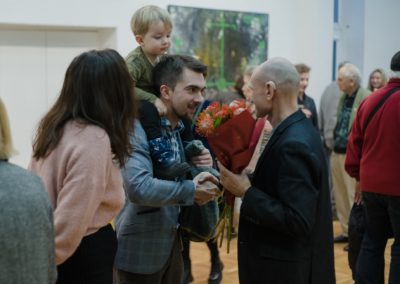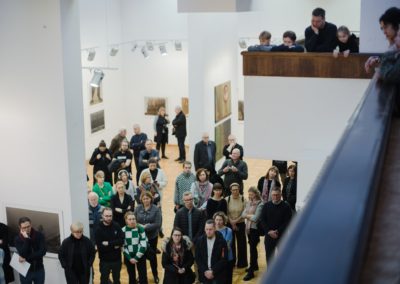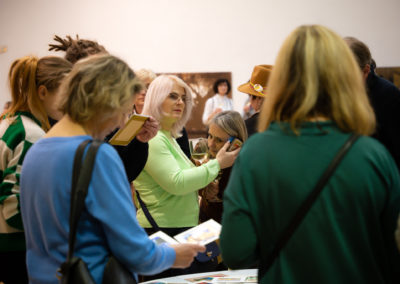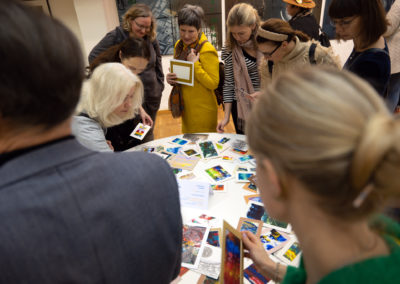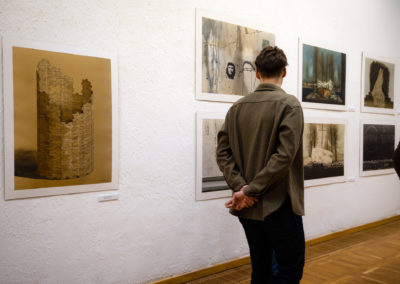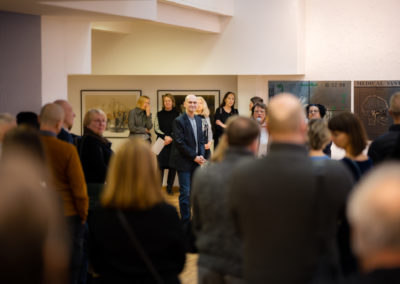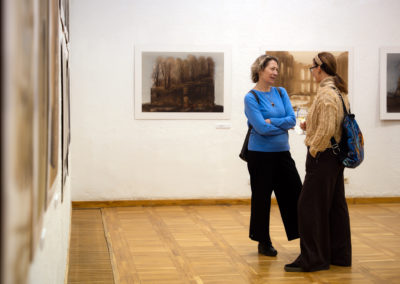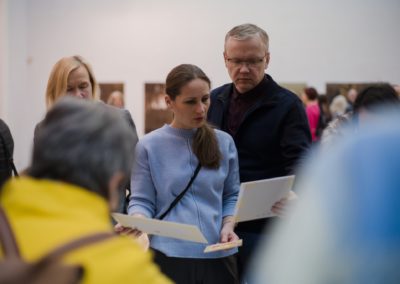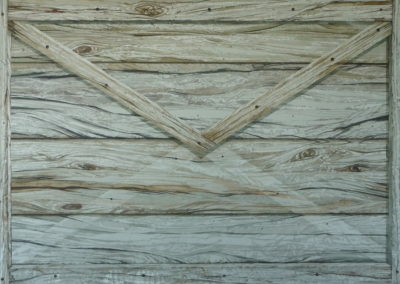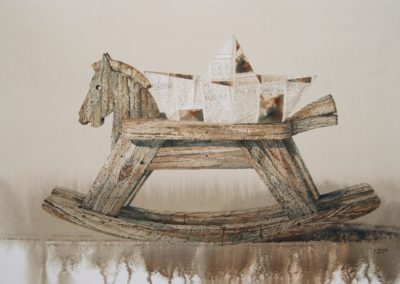2023 m. vasario 24 d., penktadienį, 17.00 val. Šiaulių dailės galerijoje atidaroma Vidmanto Zarėkos akvarelių paroda „eksPOZICIJA“.
Paroda veiks iki kovo 18 d.
Parodos atidarymo metu bus fotografuojama.
VIDMANTO ZARĖKOS AKVARELIŲ PARODA „EKSPOZICIJA“
Idėjos ir meistriškos technikos dermė – tai kūrybos principas, charakterizuojantis Vidmanto Zarėkos kūrybinius ieškojimus. Autoriui būdinga eksperimentinė, dinamiška kūryba, naujų meno kalbų paieška koreliuojanti su kūrėjo stiliaus atpažįstamumu.
Zarėka profesionaliai suvaldo tiek tradicines meno raiškas, tiek įtaigiai varijuoja šiuolaikinėmis meno technologijų galimybėmis. Autorius meno lauke išbando skirtingas teritorijas: dalyvauja tarptautinėse akvarelės bei tapybos bienalėse ir trienalėse, konceptualiose teminėse parodų erdvėse, kuria instaliacijas ar iš metalo laužo konstruoja skulptūrinius objektus.
Šioje parodoje, įprasminančioje autoriaus jubiliejų, atsigręžiama į akvarelės kūrybą: eksponuojami ankstyvosios kūrybos darbai, taip pat chrestomatiniais pavyzdžiais tapę „medinis arkliukas“ („Pasikartojimai“), ar iš sąsiuvinio lapo išlankstytas „lėktuvėlis“ (iš ciklo „Senoji mokyklinė lenta“), įvertinti tarptautinėse bienalėse kūriniai, kurie pulsuoja šių dienų aktualijomis. Nors demonstruojamų akvarelių laikotarpis ir tematinis laukas platus, jas charakterizuoja nuolatinių eksperimentų dėka suformuota, ir preciziškai įvaldoma technologija bei kontekstualumas.
Reikšminė aplinka – tai raktinis žodis, suponuojantis autoriaus kūrybos teminį interesą, dėstomą poziciją, kvestionuojantį požiūrį ar meninę kritiką. Skirtingų, sudėtingų, kompleksinių, akivaizdžiai demonstruojamų ar potekstėmis nutylėtų sociokultūrinių kontekstų atvėrimas yra kūrybinė bei intelektinė autoriaus prerogatyva. Šį procesą akvarelėse ženklina: faktūros, rašmenys, ažūrai, daiktinė aplinka ir jos simboliai, o jų būklę, ne tik fizinę bet ir vertybinių pažiūrų, fiksuoja – nykimas, virsmas, dilimas, erozija. Persvarstomi pamatiniai klausimai, kurie besikeičiant kontekstui iškyla naujai.
Akvarelės parodos pavadinimu „eksPOZICIJA“ autorius sugestijuoja dvi žiūrėjimo nuorodas: eksponuojant kūrinius siekiama ne tik juos atrinkti, išdėstyti, bet atstovauti ir būti dinamiškame santykyje kuriant poziciją bei prasmes. V. Zarėka pasitelkia klasikinę akvarelės techniką, ją jungia su Lietuvos akvarelėje nebūdinga trafaretine raiška bei plovimo technika. Meistriškais technologiškais įgūdžiais bei konceptualiomis įžvalgomis autorius įtaigiai suvaldo tiek įprasto, tiek didelio formato darbus, paneigia akvarelės liejimo stereotipus bei išplečia jos galimybes.
Paviršių V. Zarėka formuoja persidengiančių informacijos sluoksnių principu, kuris leidžia kurti tiek vizualų erdviškumą, tiek daugiasluoksnį konteksto audinį. Kuriami ženkliški, foto realistinio tikroviškumo įspūdį keliantys akvarelės darbai, modeliuojami daugiasluoksniai vaizdai indikuojantys optinius efektus, rašmenis, ažūrą, skaitmeninio vaizdo pikselius.
Autorių domina galios pozicijos, ribos ir jų peržengimai, todėl neretai vaizduojamas laikraščio motyvas tampa simboliu kvestionuojant aktualijų pobūdį. Šių dienų sociopolitinė informacija žiniasklaidoje yra gausiai iliustruojama vaizdinėmis komunikacijos priemonėmis: statistiniais duomenimis, lentelėmis, žemėlapiais, diagramomis, foto, video medžiaga. Šie iliustracijų dokumentiniai vaizdai tampa V. Zarėkos refleksijos objektu, medžiaga kūrybiniams eksperimentams bei plastinei kūrinių interpretacijai. Informacijos gausa, bei kai kurių temų pasikartojimas, taip pat svarbaus informacijos turinio talpinimas greta populiariosios kultūros atributų, neretai nureikšmina aktualijų svarbą. Todėl V. Zarėka meninėmis priemonėmis siekia praplėsti, papildyti sociopolitinius pranešimus, nesugriaunant esamų žemėlapių, diagramų, foto/video medžiagos struktūrų bei grąžinti aktualumo turinį arba atskleisti prasmes naujame kontekste – iš pirminio konteksto patalpinant į kitą, t. y. dekonstruojant iš įprastinių prasmių. Neretai žiniasklaidos pranešimuose žemėlapiai, dokumentinė foto/video medžiaga ir kt. iliustracijos perteikiamos visuomenei kaip objektyvi tikrovės reprezentacija, o šių vaizdinių vertybinis neutralumas yra pervertinamas, todėl autorius siekia permąstyti, interpretuoti komunikacinių priemonių turinį, žvelgti ne užbaigtu, o nuolat atnaujinamu, pildomu požiūriu.
Zarėkos kūrybine laboratorija tapę Lietuvos bei kaimyninių šalių kontekstas, kontroliuojamos teritorijos, optiniai prietaisai ženklinantys sprogdinimų objektus, navigacinės priemonės, stambūs žemėlapių masteliai, besikeičiančios geopolitinės padėtys, galios santykiai, ideologiškai angažuotos vaizdinės priemonės, reprezentuojančios interesus ir įtakas, šių dienų kontekste įgauna naują žiūros rakursą. Kai kurių akvarelės darbų ciklai, kurti prieš dešimt ar daugiau metų, šiandien dramatiškai rezonuoja su karo situacija Ukrainoje, o akvarelės kūrinių aktualumas pa(si)tikrinamas laiko perspektyvoje: autoriaus gvildentos temos: „Neišmoktos pamokos“ (2013), „Ateitis prasideda vakar“ (2014), ar sovietinio laikotarpio simbolių kvestionavimo ciklas „Nepatogi tiesa“ (2015) atliepia posakį: „istorija kartojasi“.
Asta Jurevičiūtė
February 24, 5:00 p.m. Vidmantas Zareka watercolor exhibition “EXHIBITION” opens in the Šiauliai Art Gallery.
The exhibition will be open until March 18.
Photographs will be taken during the opening of the exhibition.
EXHIBITION OF WATERCOLORS BY VIDMANTAS ZAREKA “EXPOSITION”
The harmony of ideas and masterful technique is the creative principle that characterizes Vidmantas Zareka creative pursuits. The author is characterized by experimental, dynamic creativity, the search for new artistic languages correlates with the recognition of the creator’s style.
Zarėka professionally controls both traditional artistic expressions and suggestively varies the possibilities of modern art technologies. The author tests different territories in the field of art: he participates in international watercolor and painting biennials and triennials, in conceptual thematic exhibition spaces, creates installations or constructs sculptural objects from scrap metal.
This exhibition, marking the author’s anniversary, looks back at the work of watercolors: early works are exhibited, as well as the “wooden horse” (“Repetitions”), which became chrestomatous examples, or the “airplane” unfolded from a notebook sheet (from the cycle “Old school board”), works that have been evaluated in international biennials and are pulsating with today’s current affairs. Although the period and thematic field of the displayed watercolors are wide, they are characterized by technology and contextuality, formed thanks to constant experiments and precisely mastered.
Meaningful environment is a keyword that presupposes the thematic interest of the author’s work, teaching position, questioning approach or artistic criticism. The opening of different, complex, complex socio-cultural contexts that are obviously demonstrated or hidden by subtexts is the author’s creative and intellectual prerogative. This process is marked in the watercolors by: textures, characters, openwork, material environment and its symbols, and their condition, not only physical but also in terms of values, is recorded – decay, transformation, wear, erosion. Fundamental questions are reexamined, which arise anew when the context changes.
The author of the watercolor exhibition entitled “EXHIBITION” suggests two viewing directions: when exhibiting works, the aim is not only to select and arrange them, but to represent them and be in a dynamic relationship creating a position and meanings. V. Zarėka uses the classic watercolor technique, combining it with stencil resolution and washing technique, which is not characteristic of Lithuanian watercolor. With masterful technological skills and conceptual insights, the author impressively controls both regular and large-format works, refutes the stereotypes of watercolor casting and expands its possibilities.
The surfaces are formed by V. Zarėka on the principle of overlapping layers of information, which allows creating both visual spatiality and a multi-layered context fabric. Iconic, photo-realistic watercolor works are created, multi-layered images are modeled indicating optical effects, characters, openwork, digital image pixels.
Authors are interested in positions of power, limits and their transgressions, so the depicted motif of the newspaper often becomes a symbol for questioning the nature of current affairs. Today’s sociopolitical information in the mass media is abundantly illustrated with visual means of communication: statistical data, tables, maps, diagrams, photos, video material. These documentary images of illustrations become the object of V. Zareka’s reflection, material for creative experiments and plastic interpretation of works. The abundance of information, as well as the repetition of some topics, as well as the placement of important information content next to the attributes of popular culture, often emphasize the importance of current events. Therefore, V. Zarėka seeks to expand and supplement sociopolitical messages through artistic means, without destroying the existing structures of maps, diagrams, photo/video material, and to return the content of relevance or to reveal meanings in a new context – by placing it from the original context into another, i.e. i.e. deconstructing from conventional meanings. It is not uncommon for media reports to include maps, documentary photo/video material, etc. illustrations are conveyed to the public as an objective representation of reality, and the value neutrality of these images is overestimated, so the author seeks to rethink, interpret the content of communication tools, to look not from a complete, but from a constantly updated, complementary point of view.
The context of Lithuania and neighboring countries, controlled territories, optical devices marking objects of bombings, navigation tools, large-scale maps, changing geopolitical positions, power relations, ideologically engaged visual tools representing interests and influences, which have become Zareka’s creative laboratory, acquire a new perspective in today’s context . The cycles of some watercolor works, created ten or more years ago, resonate dramatically with the war situation in Ukraine today, and the relevance of the watercolor works is checked in the perspective of time: the themes explored by the author: “Lessons not learned” (2013), “The future begins yesterday” (2014) whether the cycle of questioning the symbols of the Soviet period “An Inconvenient Truth” (2015) responds to the saying: “history repeats itself”.
Asta Jurevičiūtė

